-
Reagents
- Flow Cytometry Reagents
-
Western Blotting and Molecular Reagents
- Immunoassay Reagents
-
Single-Cell Multiomics Reagents
- BD® OMICS-Guard Sample Preservation Buffer
- BD® AbSeq Assay
- BD® Single-Cell Multiplexing Kit
- BD Rhapsody™ ATAC-Seq Assays
- BD Rhapsody™ Whole Transcriptome Analysis (WTA) Amplification Kit
- BD Rhapsody™ TCR/BCR Next Multiomic Assays
- BD Rhapsody™ Targeted mRNA Kits
- BD Rhapsody™ Accessory Kits
- BD® OMICS-One Protein Panels
- BD OMICS-One™ WTA Next Assay
-
Functional Assays
-
Microscopy and Imaging Reagents
-
Cell Preparation and Separation Reagents
Old Browser
This page has been recently translated and is available in French now.
Looks like you're visiting us from {countryName}.
Would you like to stay on the current location site or be switched to your location?
BD Transduction Laboratories™ Purified Mouse Anti-AKAP149
Clone 6/AKAP149 (RUO)





Western blot analysis of AKAP149 on a HeLa cell lysate (Human cervical epitheloid carcinoma; ATCC CCL-2.2). Lane 1: 1:500, lane 2: 1:1000, lane 3: 1:2000 dilution of the anti- AKAP149 antibody.

Western blot analysis of AKAP149 on a HeLa cell lysate (Human cervical epitheloid carcinoma; ATCC CCL-2.2). Lane 1: 1:500, lane 2: 1:1000, lane 3: 1:2000 dilution of the anti- AKAP149 antibody.

Immunofluorescence staining of A431 cells (Human epithelial carcinoma; ATCC CRL-1555).




Regulatory Status Legend
Any use of products other than the permitted use without the express written authorization of Becton, Dickinson and Company is strictly prohibited.
Preparation And Storage
Product Notices
- Since applications vary, each investigator should titrate the reagent to obtain optimal results.
- Please refer to www.bdbiosciences.com/us/s/resources for technical protocols.
- Caution: Sodium azide yields highly toxic hydrazoic acid under acidic conditions. Dilute azide compounds in running water before discarding to avoid accumulation of potentially explosive deposits in plumbing.
- Source of all serum proteins is from USDA inspected abattoirs located in the United States.
Companion Products


The targeting of protein kinases and phosphatases to cellular compartments in a timely manner may provide specificity in signal transduction events. For instance, attachment of type II cAMP-dependent Protein Kinase (PKA) to the cytoskeleton occurs through the binding of the regulatory subunit (RII) to microtubule associated-protein 2. Several proteins, such as microtubule-associated protein 2, have been identified as PKA type I/II anchoring proteins and form a family named AKAP (A-Kinase Anchor Proteins). AKAP149 is a protein of 903 amino acids. It has a PKA [RII] binding site at amino acids 355-376 preceded by a leucine zipper domain. AKAP149 mRNA has been reported to be expressed ubiquitously, with the highest levels in prostate and small intestine. AKAP149 contains a KH domain characteristic of RNA-binding proteins. Thus, AKAP149 is a PKA [RII] anchoring protein that may target this kinase to sites of RNA processing for regulation of RNA binding protein activity.
This antibody is routinely tested by western blot analysis. Other applications were tested at BD Biosciences Pharmingen during antibody development only or reported in the literature.
Development References (5)
-
Dell'Acqua ML, Scott JD. Protein kinase A anchoring. J Biol Chem. 1997; 272(20):12881-12884. (Biology). View Reference
-
Schillace RV, Andrews SF, Liberty GA, Davey MP, Carr DW. Identification and characterization of myeloid translocation gene 16b as a novel a kinase anchoring protein in T lymphocytes. J Immunol. 2002; 168(4):1590-1599. (Biology: Immunofluorescence, Immunoprecipitation, Western blot). View Reference
-
Steen RL, Collas P. Mistargeting of B-type lamins at the end of mitosis: implications on cell survival and regulation of lamins A/C expression. J Cell Biol. 2001; 153(3):621-626. (Biology: Immunofluorescence, Immunoprecipitation, Western blot). View Reference
-
Tanji C, Yamamoto H, Yorioka N, Kohno N, Kikuchi K, Kikuchi A. A-kinase anchoring protein AKAP220 binds to glycogen synthase kinase-3beta (GSK-3beta ) and mediates protein kinase A-dependent inhibition of GSK-3beta. J Biol Chem. 2002; 277(40):36955-36961. (Biology: Immunoprecipitation, Western blot). View Reference
-
Trendelenburg G, Hummel M, Riecken EO, Hanski C. Molecular characterization of AKAP149, a novel A kinase anchor protein with a KH domain. Biochem Biophys Res Commun. 1996; 225(1):313-319. (Biology). View Reference
Please refer to Support Documents for Quality Certificates
Global - Refer to manufacturer's instructions for use and related User Manuals and Technical data sheets before using this products as described
Comparisons, where applicable, are made against older BD Technology, manual methods or are general performance claims. Comparisons are not made against non-BD technologies, unless otherwise noted.
For Research Use Only. Not for use in diagnostic or therapeutic procedures.